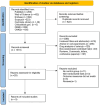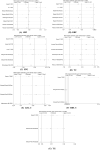Effects of celery (Apium graveolens) on blood pressure, glycemic and lipid profile in adults: a systematic review and meta-analysis of randomized controlled trials
- PMID: 40765738
- PMCID: PMC12321563
- DOI: 10.3389/fnut.2025.1597680
Effects of celery (Apium graveolens) on blood pressure, glycemic and lipid profile in adults: a systematic review and meta-analysis of randomized controlled trials
Abstract
Background: Celery is commonly used as a diet intervention for hypertension, hyperglycemia, and hyperlipidemia. However, its precise therapeutic efficacy remains uncertain.
Objective: This study aims to comprehensively evaluate the efficacy of celery preparations in regulating blood pressure, blood glucose, and blood lipids profiles in adults.
Methods: A systematic search was conducted in PubMed, Web of Science, EMBASE, Scopus, Cochrane Library, Clinicaltrials.gov, China Biology Medicine disc, and China National Knowledge Infrastructure. Randomized controlled trials of celery were included. Data were analyzed using either a random-effects model or a fixed-effects model, depending on heterogeneity, and were presented as standardized mean differences (SMDs) with corresponding 95% confidence intervals (CIs). All eligible studies were evaluated in terms of study characteristics, risk of bias, me-ta-analysis, sensitivity analysis, meta-regression, and publication bias.
Results: Our meta-analysis included ten randomized controlled studies with a total of 511 participants. The results demonstrated significant therapeutic effects of celery on systolic blood pressure (SMD: -1.0; 95% CI: -1.85 to -0.14), diastolic blood pressure (SMD: -0.93; 95% CI: -1.54 to -0.33), fasting plasma glucose (SMD: -0.80; 95% CI: -1.58 to -0.01), and triglyceride (SMD: -1.18; 95% CI: -1.45 to -0.91). However, no overall effects were observed on total cholesterol, low-density lipoprotein, or high-density lipo-protein. Subgroup analysis revealed that celery seeds or celery preparations exceeding 1,000 mg/day were more effective than other parts of celery. Additionally, no significant difference in adverse events between celery and placebo.
Conclusion: This meta-analysis demonstrated that Celery preparations significantly improve hypertension, hyperglycemia, and hyperlipidemia, with a favorable safety profile. Celery seeds or celery preparations exceeding 1,000 mg/day will have better effect. These findings suggest that celery performs well as a potential dietary supplement for reducing hypertension, hyperglycemia, and hyperlipidemia. However, the substantial heterogeneity observed for most outcomes and limited sample sizes warrant further high-quality clinical trials with longer follow-up periods to confirm these effects and establish optimal dosing regimens.
Systematic review registration: https://www.crd.york.ac.uk/PROSPERO/view/CRD42025631143, PROSPERO: CRD42025631143.
Keywords: blood pressure; celery; glycemic; lipid profile; meta-analysis.
Copyright © 2025 Liu, Zhao, Xu and Hu.
Conflict of interest statement
The authors declare that the research was conducted in the absence of any commercial or financial relationships that could be construed as a potential conflict of interest.
Figures








References
-
- Krokstad S. Worldwide trends in hypertension prevalence and progress in treatment and control from 1990 to 2019: a pooled analysis of 1201 population-representative studies with 104 million participants (vol 398, pg 957, 2021). Lancet. (2022) 399:520–520. 10.1016/S0140-6736(21)01330-1 - DOI - PMC - PubMed
Publication types
LinkOut - more resources
Full Text Sources

